Key takeaways:
- Community discussions foster connections, trust, and cooperation, alleviating feelings of isolation and sparking collective actions.
- Effective neighborhood engagement invites diverse perspectives, leading to innovative solutions and enhancing the community’s fabric.
- Organized discussions promote a sense of unity, accountability, and can result in actionable solutions to local issues.
- Creating an inclusive and engaging environment during discussions boosts participation and strengthens community bonds.
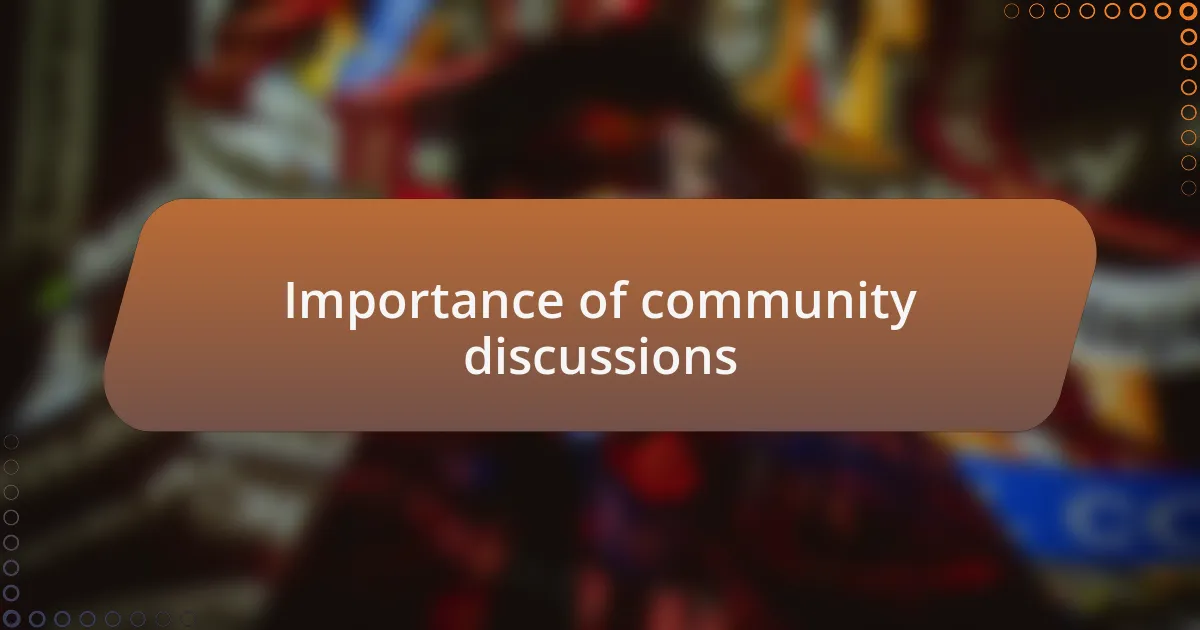
Importance of community discussions
Community discussions serve as a powerful platform for building connections among neighbors. I remember when we held our first neighborhood meeting; it was incredible to see how many people, whom I’d never spoken to before, shared the same concerns and aspirations. It made me realize that sometimes, all it takes is a space for dialogue to unlock a community’s potential.
These discussions also foster trust and cooperation, which are essential for any thriving community. Think about your own experiences—how often have you felt a little lost or disconnected? Engaging with others in a shared environment can alleviate that sense of isolation. When we come together, we learn to lean on each other, creating a more resilient neighborhood.
Moreover, community discussions can spark positive changes that impact everyone. I witnessed firsthand how an idea shared in one session led to initiatives like neighborhood cleanups and community gardens. Have you ever considered how a simple conversation could transform your surroundings? By voicing our thoughts and ideas, we ignite collective actions that can lead to a better quality of life for all.

Overview of neighborhood engagement
Neighborhood engagement is about more than just gathering to talk; it’s about creating an environment where everyone feels valued and heard. I remember one evening when we held an open forum in our local park. The sun was setting, casting a warm glow, and it sparked an energy among us. That sense of belonging, as we shared our hopes for a safer, more vibrant neighborhood, was palpable and left many of us feeling rejuvenated and empowered.
In my experience, effective neighborhood engagement often begins with an invitation—an open call to share ideas and concerns. I think back to a situation where a neighbor brought up the issue of increasing traffic and safety for children. That one comment opened a floodgate of ideas—parents began discussing safer routes to school, and soon enough, we were brainstorming ways to implement a community watch program. Have you ever observed how one individual’s concern can transform a conversation into meaningful action? It’s in these moments we find the voices that echo the needs of the community.
What’s particularly fascinating is the diversity of perspectives that emerges during these discussions. When we gather, we bring along our unique backgrounds and experiences, shaping the conversation in real-time. I recall a spirited debate over community artwork—while some championed murals celebrating our culture, others worried about potential vandalism. This conflict sparked an innovative solution: a rotating art committee that involved all voices. How often do we realize that differing opinions, when discussed openly, can lead to creativity and collaboration? Engaging with diverse viewpoints not only enriches our dialogue but also strengthens the fabric of our community.
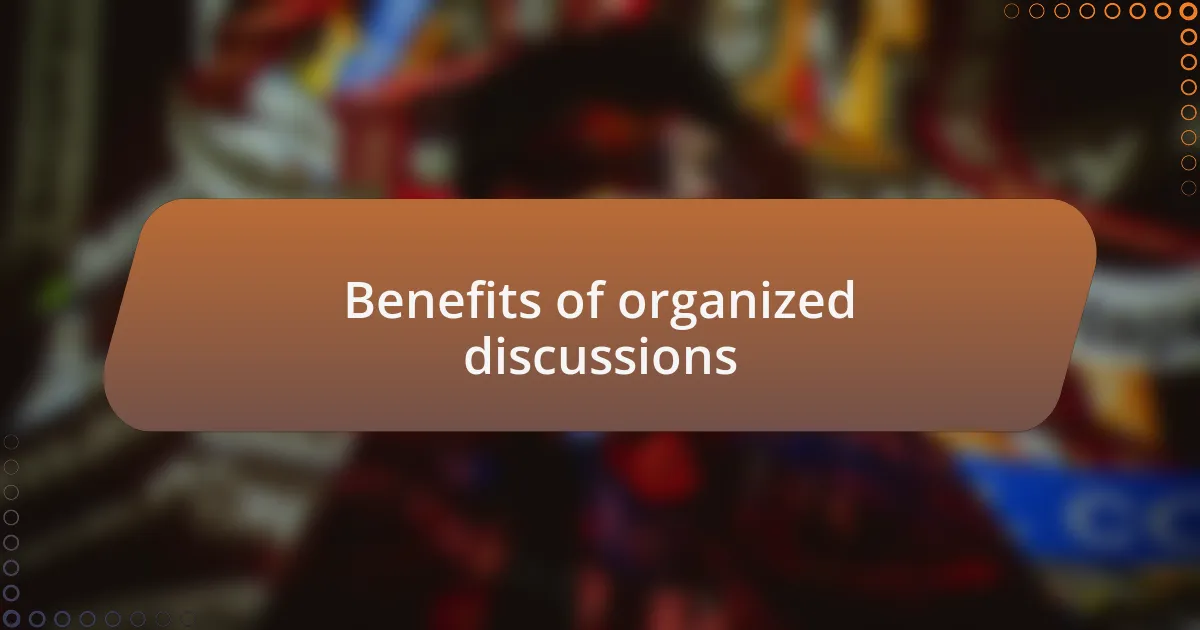
Benefits of organized discussions
Organized discussions foster a sense of community unity that is hard to replicate through casual encounters. I remember a town hall meeting where we all gathered around tables, sharing our experiences about local issues. The air buzzed with shared sentiments; it was enlightening to witness strangers turning into allies as everyone expressed their concerns about litter in the park. Isn’t it remarkable how structured conversations can bridge gaps and promote harmony among neighbors?
One significant benefit of these discussions is their potential to lead to actionable solutions. After a recent talk regarding the need for more public green spaces, I found myself volunteering for a community garden project. The way that conversation transformed into concrete action reminded me of the power of collaboration. Have you ever considered how simply talking about an idea can sow the seeds for change?
Not only do organized discussions enhance problem-solving, but they also instill a sense of accountability within the community. During one discussion session, I shared my frustration about the lack of communication from local authorities. That led to a collaborative effort, resulting in a petition for more frequent updates. Watching neighbors rally together to advocate for transparency spurred a profound feeling of civic pride. Could there be anything more inspiring than realizing that our combined voices matter and can influence decisions?
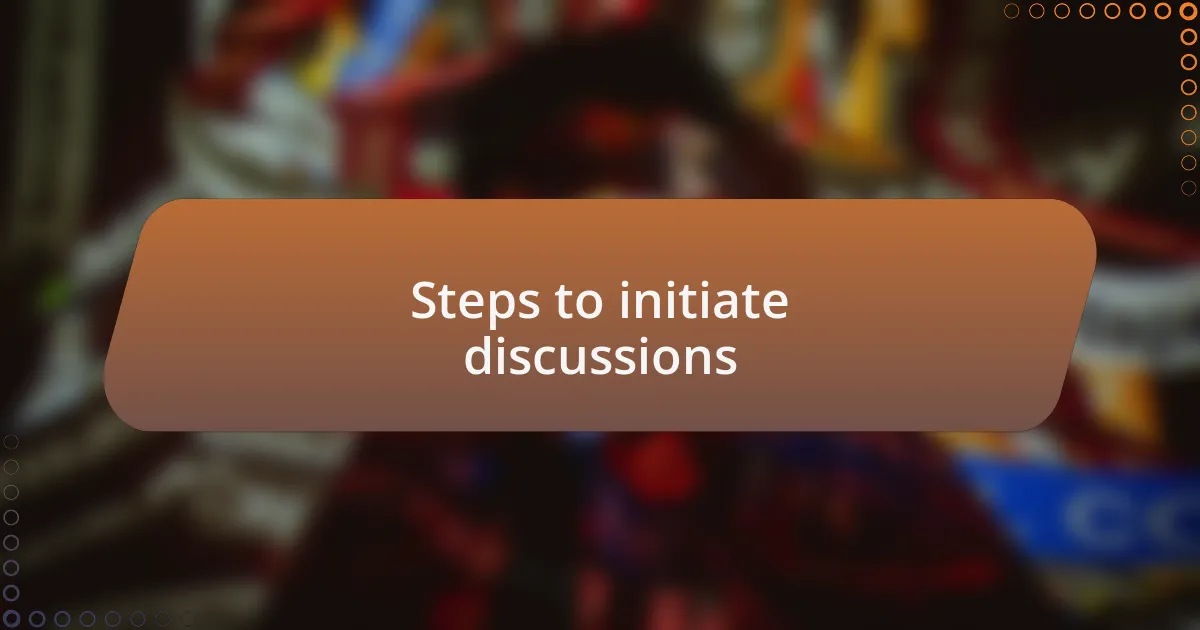
Steps to initiate discussions
To jumpstart discussions in your neighborhood, the first step is to identify a relevant topic that resonates with your community. For instance, I once noticed that traffic congestion was a growing concern among residents. It was a simple observation, yet it served as the perfect catalyst for gathering people together and encouraging them to voice their thoughts. Isn’t it interesting how identifying a common challenge can rally people into conversation?
Next, I recommend using a flexible format for your discussions. When I organized a community meeting, I opted for an informal gathering at a local café. The atmosphere was relaxed, which allowed people to share their views more comfortably. I learned that some attendees preferred small group discussions, and others enjoyed a larger forum. What have you observed works best in your community? Tailoring the format to your neighbors’ preferences is essential for fostering open dialogue.
Lastly, promoting your discussions effectively can significantly impact turnout and engagement. I found that leveraging social media platforms and community bulletin boards helped spread the word. Posting friendly reminders and highlighting the importance of the conversation excited more neighbors to participate. How can you effectively capture the attention of your community to ensure everyone’s voice is heard?
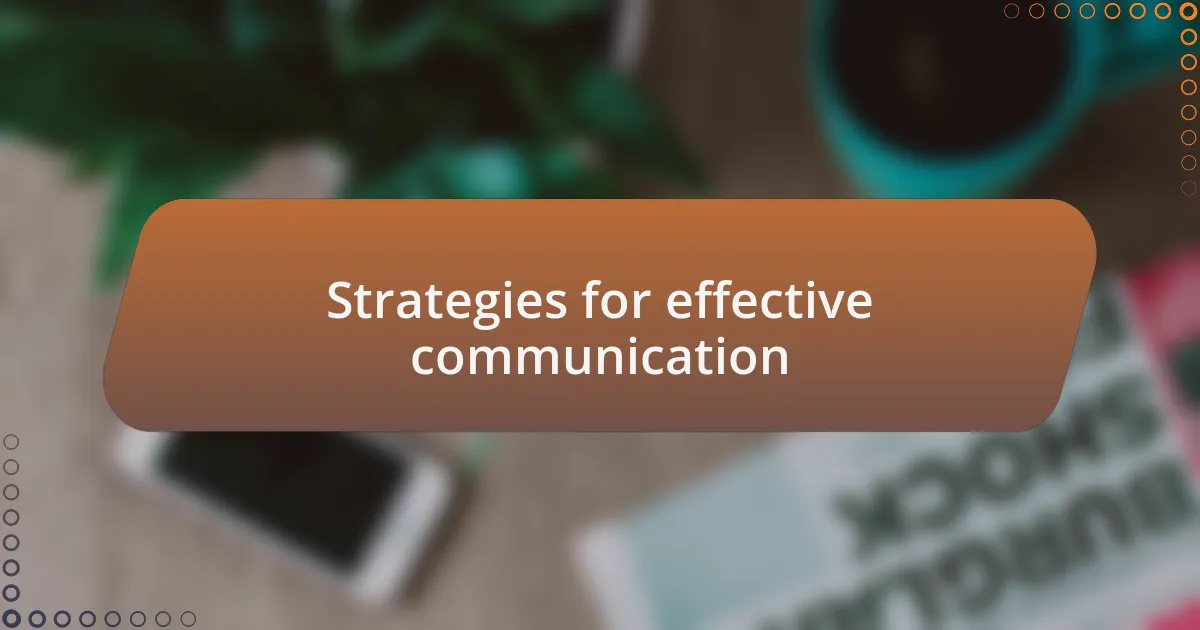
Strategies for effective communication
Effective communication is key in any neighborhood discussion. I found that actively listening to others is just as important as sharing my own thoughts. During one meeting, I noticed that when I allowed others to express their concerns first, it opened the door for deeper conversations and made them feel valued. Have you ever experienced the power of simply listening?
Another strategy I employed is encouraging participation by asking open-ended questions. This approach sparked a lively dialogue at one of my neighborhood discussions. By asking, “What do you think we can do about the local park’s condition?” I created a space for diverse opinions and solutions. It’s fascinating to see how a simple, open-ended question can lead to a cascade of ideas.
Additionally, using visual aids can enhance understanding and engagement. I once brought a large map to a discussion about local transportation issues, which allowed residents to point out specific areas of concern. This visual aspect not only clarified the conversation but also made it more interactive. Have you tried incorporating visuals in your discussions? I believe visuals can transform abstract topics into tangible issues everyone can relate to.

My personal experiences organizing sessions
Organizing neighborhood discussions has been quite a journey for me. I recall one particular session where everything seemed to align perfectly. The moment I suggested we sit in a circle instead of around a table, the atmosphere shifted. It broke down barriers, and suddenly, everyone felt more connected, as if we were all equals in this shared space.
In another instance, I faced a challenge when a few participants dominated the conversation. I realized I needed to intervene tactfully. I gently redirected the focus by saying, “Let’s hear from someone who hasn’t spoken yet.” This simple nudge not only balanced the conversation but also uplifted voices that often go unheard. Have you ever felt the satisfaction of making someone feel included? That’s what it’s all about.
One memorable session was during a rainy day when we had to move the meeting indoors. The change of setting led to a more intimate vibe, fostering unexpected friendships among neighbors. I remember laughing with someone over a shared umbrella story, which made the discussions feel less formal and more like a gathering of friends. It reminded me how the environment can influence not just the tone, but the depth of the conversations we have.
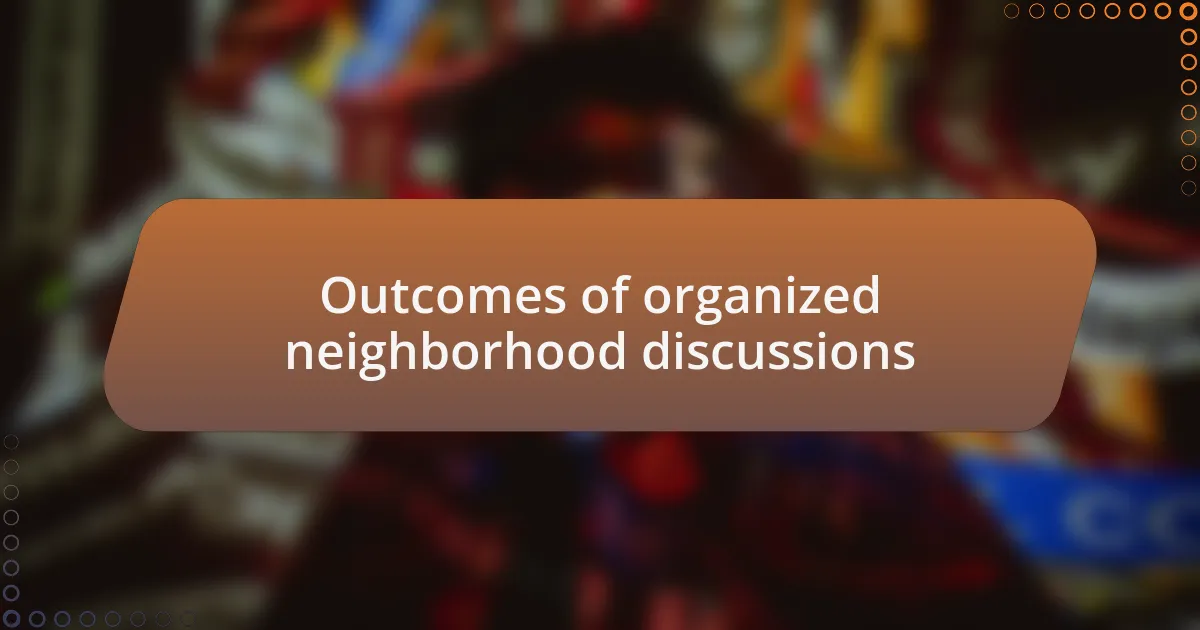
Outcomes of organized neighborhood discussions
Outcomes of organized neighborhood discussions can be transformative. After one session, I noticed a remarkable shift in community dynamics. Neighbors who once barely acknowledged each other were now actively collaborating on local projects. It felt incredible to witness how a simple conversation could spark real connections and shared goals.
Another outcome that stands out in my memory is the increased sense of belonging among participants. During one meeting, a shy neighbor shared a heartfelt story about their family’s history in the community. I watched as others leaned in, captivated. Have you ever experienced the warmth of community support? Hearing those stories truly stitched us closer together, creating a collective identity that we could all relate to.
Lastly, the discussions often lead to actionable solutions for local issues. After addressing the need for improved safety in our neighborhood, a group of us decided to form a community watch. I was thrilled to see how passionate everyone became about taking proactive steps. Isn’t it rewarding when ideas born in conversation transform into concrete actions? This illustrated how effective dialogue can shape not just awareness but also lead to meaningful change in our surroundings.